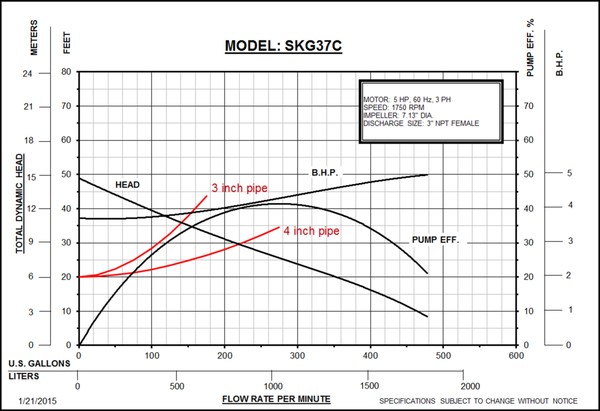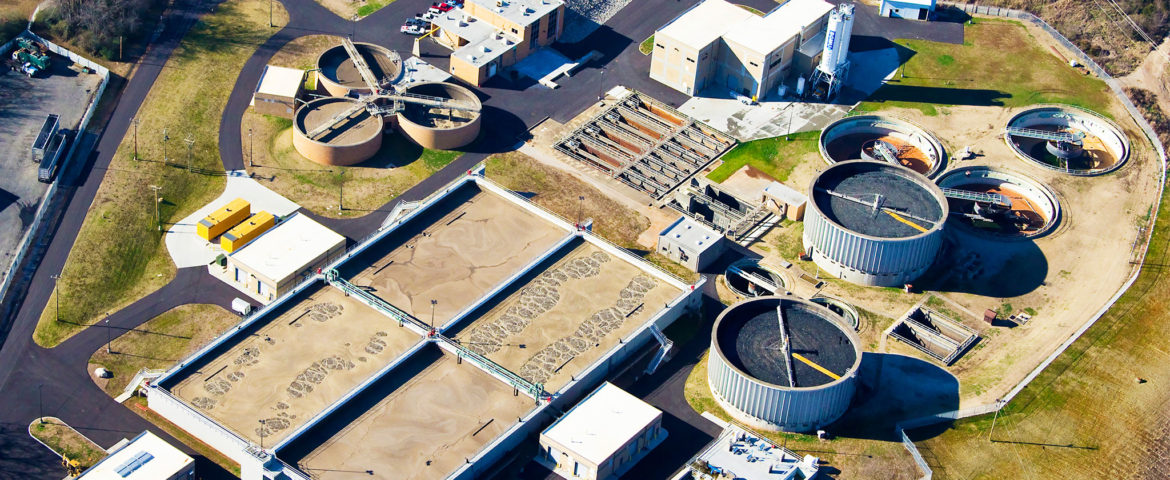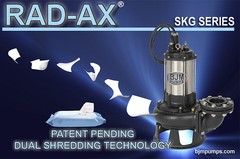RAD-AX® SKG Series Submersible Pumps
The idea of putting an electric motor under water makes most people uneasy, but slowly over the last 50 years, the use of submersible pumps has grown throughout North America. Industries here have evolved in their ways of making choices of pumping equipment. There is a trend toward submersible pumps over other options like self-priming or vertical pumps. Years of improvements in sealing systems design, manufacturing and monitoring have eased the submerged motor fears. In addition, developments in the use of slide rail systems have greatly facilitated the task of maintaining submersible pumps for wastewater applications. While the transition to using submersible pumps has been slow, it continues to be a more acceptable way of pumping, especially for wastewater treatment operators who utilize submersible pumps in a variety of applications throughout their plants.
Overcoming Clogging Issues Caused by “Flushable” Materials
Many publications, including the Washington Post, New York Times, and Consumer Reports, have recently begun to help increase awareness of a critical issue which many wastewater operators have been facing. The proliferation of handy wipes, baby wipes and other high-tensile strength fibrous materials that are marketed as “flushable” have caused major problems for wastewater treatment plants nationwide. As consumers continue to flush these materials, wastewater treatment plants must continue dealing with the clogging problems being created downstream.
While larger pumps operating in the wastewater plants may be more capable to pass these fibrous materials due to the simple nature of their suction and volute passage sizes, there are smaller pumps operating in the wastewater sump pits like sampling pumps that handle the raw, unscreened sewage but are frequently unable to process these solids. For example, in a traditional non-clog pump, the material would ball up in the eye of the impeller and clog the pump. Though larger shredder pumps typically do a good job of tearing up fibrous materials, it is the smaller horsepower pumps, such as 5 HP and smaller, where even shredder pumps can have problems passing these kinds of materials. This is an area where specialty pump manufacturers, such as BJM Pumps, have found their niche.
BJM Pumps recently developed new 5, 3, and 2-horsepower submersible pumps specifically designed to handle high-tensile strength fibrous materials. The new RAD-AX® SKG Series submersible pumps are a hybrid design that combines the best solids handling features of a non-clog shredder with the macerating capabilities of a grinder pump. Both axial and radial cutting elements are incorporated in the patent pending design. When a fibrous piece comes into the suction of the pump, it becomes engaged with the cutting mechanism both vertically and horizontally while large hard solids kick away from the suction after a small portion is nibbled away. When the material comes out on the other side, it has been turned into a pulp that passes easily through the pump. Having the options to install smaller specialty pumps is critical for wastewater operators when they have to size their pumps appropriately, taking into consideration energy usage, piping issues and system design.
Sizing the Pump for a Specific Application
It is surprising how often pumps get purchased and installed without a simple review of the application’s hydraulic characteristics. This is a critical part of any good pump sizing and selection work. Beginning with the required flow rate and pipe size determination it becomes a simple matter to estimate and display graphically these characteristics with a system curve specific for the application.
There are two basic elements to any system:
- Static head: For systems with an open-to-atmosphere discharge point, this is simply the elevation difference between the level in the pump wet well and the discharge point.
- Friction loss: These are losses in the piping system and they are directly related to the flow rate, size and length of piping, valves, elbows and other fittings.
Knowing these two elements, the static head and the friction loss, will allow you to create a system curve, which will in turn, help you determine the best pump to use in that specific application. [See figure 1.]

The system curve here shows static head of 20 ft. along the vertical y-axis and the flow rate is shown on the horizontal x-axis. As flow increases, the system curve swings upward due to the friction in the pipe length, valves, elbows and other fitting losses. Typical centrifugal pumps produce the most head at 0 flow and as the flow rate increases the pressure (head) is reduced. A partially closed discharge valve adds pressure drop (friction) in the system. Fully opened, the pump will operate at the point where the system and pump curve intersect. Similarly, the effects of changing pipe size are shown here.
Considering the value of improved pump life and reduced energy costs, it is important to spend a little time up front in the pump selecting process understanding the system. Plotting a system curve is a simple way to display and understand how the pump will behave in the application.
Solving Problems with Information Technology and Responsive Service
Technology is always changing. Pumps are becoming more efficient and more capable of handling the challenges of modern sewer systems, and leading pump manufacturers are developing web-based tools to support pump selections. For instance, BJM Pumps uses cloud-based technology to provide their distributors with an online pump selection tool. Distributor application engineers can log into the portal, enter the static head, the length of the pipe, the size of the pipe, and within minutes, pick the BJM pump that is most efficient for that specific application. Once the right pump is selected, the engineer can also use the portal to access real-time data on the availability of the pump. When a pump goes down, wastewater operators need a solution FAST. Modern information technology enables service and support providers to get online, quickly analyze a system, determine the best pump for the application, and then generate quick, reliable estimates that turn into purchase orders. What did take days now takes minutes and in quick order, a maintenance headache can be replaced with an efficient, reliable submersible pump.
Not only is it important to work with a reputable distributor or directly with a responsive pump manufacturer, it is critical for wastewater operators to realize they have options. With so many consolidations of OEMs into larger organizations, it is crucial for small- and medium-sized companies, like BJM Pumps, to continue to provide the marketplace with specialized pumping equipment that helps pump users solve their day-to-day challenges.
MECO is your source for BJM Pumps in the Carolinas. Contact MECO today for all of your BJM Pump needs!



